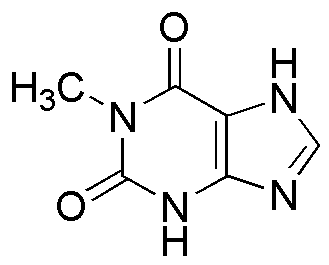1-Methylxanthine is widely utilized in research focused on:
- Pharmaceutical Development: This compound is studied for its potential therapeutic effects, particularly in respiratory diseases, where it may help relax bronchial muscles and improve airflow.
- Caffeine Research: As a structural analog of caffeine, it serves as a valuable tool in understanding the pharmacological effects of methylxanthines, aiding in the development of caffeine-related products.
- Neuroscience Studies: Researchers explore its role in modulating neurotransmitter systems, which can provide insights into cognitive function and mental health treatments.
- Food and Beverage Industry: It is used in the formulation of energy drinks and dietary supplements, appealing to consumers seeking enhanced energy and alertness.
- Veterinary Medicine: The compound is investigated for its effects on animal health, particularly in improving respiratory function in pets and livestock.
General Information
Properties
Safety and Regulations
Applications
1-Methylxanthine is widely utilized in research focused on:
- Pharmaceutical Development: This compound is studied for its potential therapeutic effects, particularly in respiratory diseases, where it may help relax bronchial muscles and improve airflow.
- Caffeine Research: As a structural analog of caffeine, it serves as a valuable tool in understanding the pharmacological effects of methylxanthines, aiding in the development of caffeine-related products.
- Neuroscience Studies: Researchers explore its role in modulating neurotransmitter systems, which can provide insights into cognitive function and mental health treatments.
- Food and Beverage Industry: It is used in the formulation of energy drinks and dietary supplements, appealing to consumers seeking enhanced energy and alertness.
- Veterinary Medicine: The compound is investigated for its effects on animal health, particularly in improving respiratory function in pets and livestock.
Documents
Safety Data Sheets (SDS)
The SDS provides comprehensive safety information on handling, storage, and disposal of the product.
Product Specification (PS)
The PS provides a comprehensive breakdown of the product’s properties, including chemical composition, physical state, purity, and storage requirements. It also details acceptable quality ranges and the product's intended applications.
Certificates of Analysis (COA)
Search for Certificates of Analysis (COA) by entering the products Lot Number. Lot and Batch Numbers can be found on a product’s label following the words ‘Lot’ or ‘Batch’.
*Catalog Number
*Lot Number
Certificates Of Origin (COO)
This COO confirms the country where the product was manufactured, and also details the materials and components used in it and whether it is derived from natural, synthetic, or other specific sources. This certificate may be required for customs, trade, and regulatory compliance.
*Catalog Number
*Lot Number
Safety Data Sheets (SDS)
The SDS provides comprehensive safety information on handling, storage, and disposal of the product.
DownloadProduct Specification (PS)
The PS provides a comprehensive breakdown of the product’s properties, including chemical composition, physical state, purity, and storage requirements. It also details acceptable quality ranges and the product's intended applications.
DownloadCertificates of Analysis (COA)
Search for Certificates of Analysis (COA) by entering the products Lot Number. Lot and Batch Numbers can be found on a product’s label following the words ‘Lot’ or ‘Batch’.
*Catalog Number
*Lot Number
Certificates Of Origin (COO)
This COO confirms the country where the product was manufactured, and also details the materials and components used in it and whether it is derived from natural, synthetic, or other specific sources. This certificate may be required for customs, trade, and regulatory compliance.


